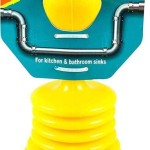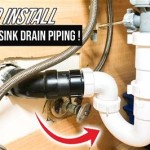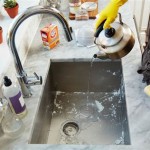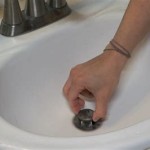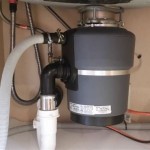Flexible P Trap for Bathroom Sinks: A Comprehensive Guide
The plumbing system beneath a bathroom sink is a critical component, responsible for efficiently channeling wastewater away from the basin and preventing sewer gases from entering the living space. Among the various components that comprise this system, the P-trap holds a pivotal role. While traditional rigid P-traps have been the standard for many years, flexible P-traps offer a compelling alternative, particularly in situations where space constraints or complex plumbing configurations present challenges.
This article delves into the functionality, advantages, disadvantages, installation considerations, and maintenance aspects of flexible P-traps designed for bathroom sinks, providing a comprehensive understanding of their role in residential plumbing.
A P-trap is a curved section of pipe designed to hold a small amount of water. This trapped water acts as a barrier, preventing sewer gases, which often contain methane and hydrogen sulfide, from rising up through the drain and entering the bathroom. These gases can be unpleasant, and in high concentrations, potentially harmful. The design of the P-trap ensures that fresh water replenishes the trap after each use of the sink, maintaining the seal.
Flexible P-traps are constructed from corrugated or smooth, pliable materials, typically polypropylene or PVC. This flexibility allows them to be bent and adjusted to fit various sink configurations and accommodate obstructions that might impede the installation of a rigid P-trap. This adaptability makes them a valuable option for DIY projects, renovations, and situations where precise measurements are difficult to achieve.
Understanding the Key Advantages of Flexible P-Traps
Flexible P-traps offer several distinct advantages, making them a popular choice for certain bathroom installations. These advantages primarily relate to ease of installation and adaptability, addressing common challenges encountered during plumbing work.
Ease of Installation: The primary advantage of a flexible P-trap lies in its ease of installation. The flexible material allows for adjustments and bends that would be impossible with rigid PVC or metal pipes. This is particularly beneficial in situations where the sink drain and the drainpipe in the wall do not align perfectly. Instead of precisely cutting and fitting rigid pipes, the flexible P-trap can be easily maneuvered to connect the two points. This simplicity reduces the need for specialized tools and expertise, making it a viable option for homeowners undertaking DIY plumbing projects.
The adjustable length of many flexible P-traps further simplifies installation. These traps often consist of a telescopic section that can be extended or retracted to achieve the precise length required. This eliminates the need for meticulous measurements and cutting, reducing the risk of errors and material wastage.
Adaptability to Confined Spaces: Bathrooms, particularly older ones, often present limited space for plumbing installations. The area beneath the sink can be cramped, making it challenging to maneuver and connect rigid pipes. Flexible P-traps excel in these situations, as their pliability allows them to be snaked around obstructions and fitted into tight spaces. This adaptability is particularly useful in pedestal sinks or vanities with limited storage space.
The flexible nature of these traps also makes them suitable for installations where the drainpipe is located in an unusual or inconvenient position. Rather than rerouting the existing plumbing, a flexible P-trap can be used to bridge the gap and make the connection.
Cost-Effectiveness: Flexible P-traps are generally more cost-effective than rigid PVC or metal P-traps, especially when considering the cost of additional fittings and tools that may be required for rigid pipe installations. The simplicity of installation can also save on labor costs if a professional plumber is not required. For budget-conscious homeowners, flexible P-traps offer a practical and economical solution.
The savings associated with flexible P-traps extend beyond the initial purchase price. Their ease of installation can reduce the time required to complete the plumbing project, minimizing disruption and inconvenience.
Addressing the Disadvantages and Limitations
Despite their advantages, flexible P-traps also have certain disadvantages that should be considered before making a purchasing decision. These disadvantages primarily relate to durability and potential for clogs.
Durability Concerns: Flexible P-traps are generally less durable than rigid PVC or metal P-traps. The flexible material, typically polypropylene or PVC, is more susceptible to damage from physical impact or exposure to harsh chemicals. Over time, the material can become brittle and crack, leading to leaks. It's important to consider the quality of the material and the intended use of the sink when selecting a flexible P-trap. High-quality flexible P-traps made from durable materials will offer greater longevity.
The corrugated design of some flexible P-traps can also contribute to durability issues. The ridges and crevices can trap debris and grime, making them difficult to clean and potentially leading to corrosion or deterioration of the material.
Potential for Clogs: The corrugated inner surface of some flexible P-traps can trap debris and hair, increasing the likelihood of clogs. The uneven surface provides more surface area for particles to adhere to, hindering the smooth flow of water and waste. Over time, these accumulated particles can build up and completely block the drain.
While smooth-walled flexible P-traps mitigate this issue to some extent, they are still generally more prone to clogs than rigid pipes with smooth inner surfaces. Regular maintenance and cleaning are essential to prevent clogs in flexible P-traps.
Code Compliance Issues: In some jurisdictions, flexible P-traps may not be compliant with local plumbing codes. It's crucial to check with the local building department or a qualified plumber to ensure that flexible P-traps are permitted in the specific area. Code compliance is essential to ensure the safety and integrity of the plumbing system.
Plumbing codes are designed to ensure that plumbing systems meet minimum standards for safety, sanitation, and efficiency. Non-compliant installations can result in fines or mandatory corrections. Therefore, verifying code compliance is a critical step before installing any plumbing component.
Installation and Maintenance Considerations
Proper installation and regular maintenance are critical to ensure the optimal performance and longevity of a flexible P-trap. Following the manufacturer's instructions carefully during installation is essential, and routine cleaning will help prevent clogs and maintain the integrity of the system.
Installation Process: The installation of a flexible P-trap typically involves connecting the trap to the sink drain and the drainpipe in the wall. The process usually involves tightening compression fittings or slip nuts. It's crucial to ensure that all connections are secure and watertight to prevent leaks. Using Teflon tape on threaded connections can help to create a tighter seal.
When installing a flexible P-trap, it's important to avoid over-tightening the fittings, as this can damage the plastic material. Hand-tightening is usually sufficient, followed by a slight tightening with a wrench. It's also important to ensure that the P-trap is properly aligned and that there are no kinks or sharp bends in the flexible pipe. These kinks can restrict the flow of water and increase the risk of clogs.
Maintenance Procedures: Regular maintenance is essential to prevent clogs and maintain the cleanliness of the flexible P-trap. Flushing the drain with hot water and a drain cleaner on a regular basis can help to remove accumulated debris and prevent clogs. It's also important to avoid pouring grease or oil down the drain, as these substances can solidify and contribute to clogs.
Periodically inspecting the flexible P-trap for leaks or damage is also recommended. If any leaks or cracks are detected, the trap should be replaced immediately to prevent water damage. Regular maintenance will extend the lifespan of the flexible P-trap and ensure its continued functionality.
In the event of a clog, the flexible P-trap can be easily disassembled for cleaning. Simply loosen the compression fittings or slip nuts and remove the trap. Use a plumbing snake or wire hanger to remove any debris or obstructions. Rinse the trap thoroughly with water before reassembling it. For stubborn clogs, a chemical drain cleaner may be necessary, but it's important to follow the manufacturer's instructions carefully and wear appropriate safety gear.
Choosing the right type of flexible P-trap is also important for long-term performance. Smooth-walled flexible P-traps are generally less prone to clogs than corrugated traps. Flexible P-traps made from high-quality, durable materials will also last longer and resist damage.
Flexible P-traps can be a practical solution for bathroom sink plumbing, particularly in situations where space is limited or complex configurations exist. However, it is essential to weigh the advantages and disadvantages, considering factors such as durability, potential for clogs, and code compliance. Proper installation and regular maintenance are critical for ensuring their optimal performance and longevity. By understanding these factors, informed decisions can be made regarding the suitability of flexible P-traps for specific bathroom sink installations.

Simple Drain Rubber Sink Kit

Simple Drain 1 25 In Rubber Threaded P Trap Bathroom Single Sink Kit 3ea 1v2 Tc0 The Home

Oatey Hdc9689 1 4 In Form N Fit Flexible P Trap

Oatey Form N Fit 1 2 In White Plastic Sink Drain Flexible P Trap C3522605 The Home

Keeney 81240k 1 2 In Plastic P Trap

Simple Drain 1 25 In Rubber Threaded P Trap Bathroom Single Sink Kit 3ea 1v2 Tc0 The Home

Keeney 81240k 1 2 In Plastic P Trap

Oatey 1 4 In Form N Fit Flexible P Trap Hdc9689

Crushproof Tubing Simple Drain 1 25 In Rubber Threaded P Trap Bathroom Single Sink Kit White

Bathroom Kitchen Flexible Tube Pipe Sink Basin Water 1 2 P Trap Drain Hose

